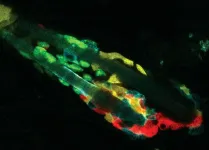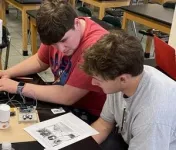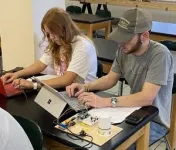(Press-News.org) Billions of our cells die every day to make way for the growth of new ones. Most of these goners are cleaned up by phagocytes—mobile immune cells that migrate where needed to engulf problematic substances. But some dying or dead cells are consumed by their own neighbors, natural tissue cells with other primary jobs. How these cells sense the dying or dead around them has been largely unknown.
Now researchers from The Rockefeller University have shown how the sensor system operates in hair follicles, which have a well-known cycle of birth, decay, and regeneration put into motion by hair follicle stem cells (HFSCs). In a new study published in Nature, they demonstrate that a duo of sensors works in tandem to pick up signals from both dying and living HFSCs, removing debris before tissue damage can occur and ceasing operation before healthy cells are consumed.
“The system is seemingly spatially tuned to the presence of corpses, and it only functions when each receptor picks up the signal is attuned to,” says first author Katherine Stewart, a research associate in the Robin Chemers Neustein Laboratory of Mammalian Cell Biology and Development at Rockefeller. “If one of them disappears, the mechanism stops operating. It’s a really beautiful way to keep the area clean without consuming healthy cells.”
“By diverting their attention towards eating their dying neighbors, HFSCs keep inflammation-generating immune cells away,” says Elaine Fuchs, head of the lab. “They also likely benefit from these extra calories, but as soon as the debris is cleared, they must quickly return to their jobs of maintaining the stem cell pool and making the body’s hair.”
Following the cycle
Every single hair follicle on your head goes through a specific cycle: growth, destruction, rest, and—as seen in your shower drain—shedding.
To initiate the process, hair follicle stem cells (HFSCs), located in the “bulge” of the follicle’s upper root sheath, signal to epithelial and mesenchymal cells, sparking growth. This stage takes its time, lasting from two to six years.
The destructive, or catagen, stage that follows is brief but intense, obliterating about 80% of the hair follicle in just a few weeks. The process begins at the follicle base and works its way upwards towards the HFSC niche. The result is a mass of dying and dead cells that need removal to prevent the resulting decay from triggering inflammatory or autoimmune responses.
Normally this would be the job of phagocytes like macrophages, but few are found in the hair follicle, meaning it must fall to local epithelial cells to keep things tidy. Stewart wanted to determine the chemical communication that manages the process.
Dynamic duo
She and her colleagues took a closer look at the catagen phase in mouse hair follicles, whose hair cycle is short and synchronous across the hair coat. It’s only at the later stage of catagen that the death signals originating in the follicle base finally reach the spot where undifferentiated stem cells reside. It had long been thought that stem cells were spared from the destruction, but surprisingly, the team found that some do die—and are engulfed by their neighbors.
Stewart discovered that the clearing out can only begin when two receptors are both activated in the healthy cells. The first, called RXRα, detects the presence of lipids, one of several well-known “find me” signals secreted by a dying cell. The second, called RARγ, senses growth-promoting retinoic acid secreted by healthy cells.
Neither can activate the cleanup process alone. “A dying cell triggers the mechanism to begin, and when there are no dead cells left, the lipid signal disappears, leaving only the retinoic acid signal from the healthy cells,” Stewart says. “This tells the program to dampen back down. It’s so elegant in its simplicity.”
They also documented that macrophages were slow to migrate to the region, showing up as much as four days after cell death. “It’s been pretty broadly thought that professional phagocytes eventually swoop in and do the heavy cleanup, and that non-motile cells were a sort of backup system,” she says. “I was very surprised to find that the hair follicle stem cells were actually the first responders, especially because mouse skin is fairly well-endowed with macrophages, so they’re not even that far away.”
They also found that tissue damage occurred when the HFSCs were prevented from clearing dying cells and left the work to the macrophages. This raises the possibility that genetic defects in this process might contribute to human skin pathologies, including inflammation and hair loss.
Positive or negative?
The HFSCs that consumed nearby dying cells—some ate as many as six of their neighbors—may benefit from ingesting the cells’ proteins, nucleic acids, solutes, and lipids. If that’s the case, the perks remain to be understood—a subject the Fuchs lab will investigate in the future.
“It’s possible that they can use that material to fuel their own growth or benefit from it in some other way,” Stewart says, “but it’s equally possible that it has negative effects. Maybe they’re too occupied with digesting all this material to take care of their normal duties.”
The findings have applications beyond the hair follicle, because it is only one of several areas of the body where there are few professional phagocytes around. In regions of the brain, breasts, and lungs, for example, epithelial and mesenchymal tissue cells, including stem cells, moonlight as ersatz phagocytes.
“We often use the phrase ‘you are what you eat,’” adds Fuchs. “For our body’s stem cells, this may be their way of keeping tissues fit by clearing out naturally dying cells and guarding against inflammation.”
END
Surprising mechanism for removing dead cells identified
2024-08-21
ELSE PRESS RELEASES FROM THIS DATE:
UC Irvine discovery of ‘item memory’ brain cells offers new Alzheimer’s treatment target
2024-08-21
Irvine, Calif., Aug. 21, 2024 — Researchers from the University of California, Irvine have discovered the neurons responsible for “item memory,” deepening our understanding of how the brain stores and retrieves the details of “what” happened and offering a new target for treating Alzheimer’s disease.
Memories include three types of details: spatial, temporal and item, the “where, when and what” of an event. Their creation is a complex process that involves storing information based on the meanings and outcomes of different experiences and forms the foundation of our ability to recall and recount them.
The study, published ...
Study shows successful use of ChatGPT in ag education
2024-08-21
By John Lovett
University of Arkansas System Division of Agriculture
FAYETTEVILLE, Ark. — Artificial intelligence tools such as ChatGPT show promise as a useful means in agriculture to write simple computer programs for microcontrollers, according to a study published this month.
Microcontrollers are small computers that can perform tasks based on custom computer programs. They receive inputs from sensors and can be used in climate and irrigation controls, food processing systems, as well as robotic and drone applications, to name a few agricultural uses.
A recent study published with the Arkansas Agricultural ...
Early interventions may improve long-term academic achievement in young childhood brain tumor survivors
2024-08-21
(MEMPHIS, Tenn. – August 20, 2024) Children who survive a brain tumor often experience effects from both the cancer and its treatment long after therapy concludes. Scientists at St. Jude Children’s Research Hospital found very young children treated for brain tumors were less prepared for school (represented by lower academic readiness scores) compared to their peers. This gap persisted once survivors entered formal schooling. Children from families of higher socioeconomic status were partially protected from the effect, suggesting that providing early developmental resources may proactively help reduce the academic achievement gap. The findings were published today in ...
Cholecystectomy not always necessary for gallstones and abdominal pain
2024-08-21
Each year, 100,000 people visit their doctor with abdominal pain, with approximately 30,000 of them diagnosed with gallstones. The standard treatment for these patients is a laparoscopic cholecystectomy. Since the 1990s, the number of surgeries has increased exponentially, despite the lack of clear international criteria. As a result, gallbladder removal is one of the most common surgeries in the Netherlands, yet it is not always effective against pain: about one-third of patients continue to experience abdominal pain after cholecystectomy. The procedure has long been an example of inappropriate care, but this is now changing.
In a 2019 study conducted by Radboud university ...
Greenhouse gas HFC-23: Abatement of emissions is achievable
2024-08-21
Hydrofluorocarbons (HFCs) are potent greenhouse gases (GHGs). The most potent of these compounds is trifluoromethane, also known as HFC-23. One kilogram of HFC-23 in the atmosphere contributes as much to the greenhouse effect as 12,000 kilograms of CO₂. It takes around 200 years for the gas to break down in the atmosphere. For this reason, more than 150 countries have committed to significantly reducing their emissions of HFC-23 as part of the Kigali Amendment to the Montreal Protocol.
The main source of HFC-23 ...
Researchers identify most common long COVID symptoms in children and teens
2024-08-21
Aug. 21, 2024--Researchers from the NIH’s RECOVER Initiative have determined what long COVID looks like in youths, based on the most common symptoms reported in a study of over 5,300 school-age children and adolescents.
Using the findings, published today in the Journal of the American Medical Association, the researchers also created indices that contain prolonged symptoms—eight for school-age children and 10 for adolescents—that together most likely indicate long COVID.
The indices are not intended to be used in making a clinical diagnosis of long COVID but will guide research to improve diagnosis, treatment, and prevention of the condition in youths.
“Many ...
NIH-funded study finds long COVID affects adolescents differently than younger children
2024-08-21
NIH-funded study finds long COVID affects adolescents differently than younger children Adolescents were most likely to experience low energy/tiredness while children were most likely to report headache
Scientists investigating long COVID in youth found similar but distinguishable patterns between school-age children (ages 6-11 years) and adolescents (ages 12-17 years) and identified their most common symptoms. The study, supported by the National Institutes of Health (NIH) and published in JAMA, comes from research conducted through the NIH’s Researching ...
Characterizing long COVID in children and adolescents
2024-08-21
About The Study: In this large-scale study, symptoms that characterized pediatric postacute sequelae of SARS-CoV-2 infection (PASC), or long COVID, differed by age group, and several distinct phenotypic PASC presentations were described. The research indices developed here will help researchers identify children and adolescents with high likelihood of PASC. Although these indices will require further research and validation, this work provides an important step toward a clinically useful tool for diagnosis with the ultimate goal of supporting optimal care for youth with PASC.
Quote from corresponding author Rachel ...
Researchers aim to pull back the curtain on long COVID in kids
2024-08-21
The kids were correct all along.
In the most comprehensive national study since the onset of the COVID-19 pandemic, a team of researchers that includes a Rutgers-organized consortium of pediatric sites has concluded that long COVID symptoms in children are tangible, pervasive, wide ranging and clinically distinct within specific age groups.
Results of the study, funded by the National Institutes of Health (NIH), are published in the Journal of the American Medical Association.
“We have convincing evidence that COVID-19 is not just a mild, benign illness for children,” ...
RECOVER study determines most common long COVID symptoms in children and teens
2024-08-21
A research team led by the National Institutes of Health’s RECOVER Initiative and supported by its Clinical Science Core (CSC) at NYU Langone Health, has designed a new way to identify which school-age children and adolescents most likely have Long COVID.
Solely for the purpose of further study and not for use in clinical diagnoses, the team’s new measure (index) identifies children and teens with the highest chances of having Long COVID. The research index is based on long-term symptoms ...




